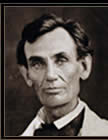by Claude N. Frechette, M.D.
Material and Methods
Because this is what could be called a 150-year-old case, I obviously could not gather diagnostic data by using today's sophisticated medical technology and equipment. I relied on accounts by Lincoln's law partner, William H. Herndon, letters from family and contemporaries, biographical materials, personal revelations {8}, papers by doctors on Lincoln's physical {9} and emotional problems {10}, scores of Lincoln photographic portraits, as well as a copy of a life mask, the original made just before Lincoln became president {11}.
In the 107 likenesses of Lincoln that I studied, the point of focus, angle of pose, head inclination, magnification, and lighting were all different {12}. Distortion inherent in photography also had to be taken in to account. The effects of weight-change, aging, and mental condition were duly noted.
Anthropomorphic Analysis
An analysis of facial features using the canon of the vertical Golden Proportions appeared to be a valid approach to this unique project, because facial proportions can be determined mathematically {13}. An interesting and extensive discussion of this subject is contained in the article "Divine Proportion in Facial Esthetics" by Robert M. Ricketts, M.D. {14}. This canon is a basis for a system of mathematically developed proportions that have led to standard facial and cranial measurements enabling plastic, reconstructive, and orthodontic surgeons to use photographs to evaluate deviations from ideal, standard norms.
Although a prerequisite set of standardized photographs of Lincoln does not exist, I thought that cardinal or outstanding facial features - lips, eyelids, etc. - could still be used as vertical reference points if they were easily recognizable, regardless of the angle of the pose {15,16,17,18}.
The measured distance between these points would be proportionately accurate in a given portrait if realistic limits were pre-defined. Errors in measurement, even of the same photographic subject, would be impossible to avoid, given the subjective conditions of this retrospective study. Nonetheless, such errors could be expected to be small compared with the gross differences that would be found in individuals having different facial structures.
Only 15 of the known images of Lincoln were finally selected for close scrutiny solely because their poses were similar to the one in the Kaplan in that they all featured the left side of the face. The scores of other Lincoln images that were excluded were rejected simply because they all featured the other side of Lincoln's face. Later in life, Lincoln preferred to have his right side photographed, whereas the Kaplan daguerreotype, like Meserve #1 and the 1862 photograph shown in Figure 2, shows his left side.
Figure 2
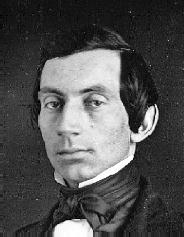 Kaplan Daguerreotype Early 1840's |
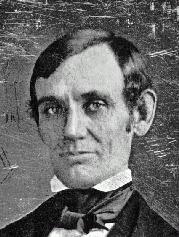 Meserve #1 1848 |
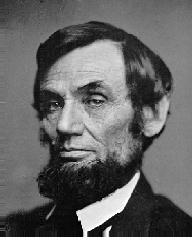 President Lincoln 1862 |
Six of the selected portraits showed Lincoln with a beard. They were, nevertheless, analyzed, because even though the chin could not be pinpointed, the images could be used as a means of counter-checking the accuracy of the method used in locating the position of the central and upper facial features.
Each of the selected images was re-photographed and then enlarged or reduced in order to standardize the interpupillary distances (Figure 3), thereby, in the pursuit of increasing accuracy, removing at least one of the variables. Each print measured 26.5 cm x 33 cm, with interpupillary (IP) distance of 5.4 cm. (Figure 4).
Figure 3
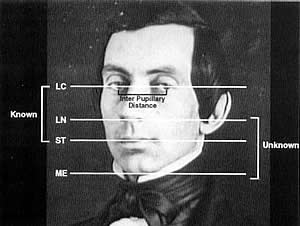
The level of the eyes (LC) [Lateral Canthus] and the position of the lips (ST) [Stomatodeum] were chosen as "known" reference points. The positions of the nose (LN) [Lateral Nares] and chin ( ME) [Mentum] were considered as "unknowns." ME was calculated from the distance LC-ST and LN measured from ME. In this way, the height of the lower and central segments of the face could be broken down to include the lower lip and chin (mandible), and the upper lip, cheek, and nose (maxilla).
LC was drawn as a line from the lateral-most (outer) limits of the sclera
(the white of the eye) in both eyes. This served as a "horizontal" of
the face as a whole to which other facial features could be oriented.
ST was determined at the lowest point of the upper lip tubercle (the
thickening in the middle of the upper lip). A short line was then drawn
parallel to LC, and the distance between LC and ST measured with a caliper
to the closest 1/100th of a centimeter. ME was then calculated from ST
as the shorter distance (0.618) of the golden section, taking LC-ST as
1.000. Once ME was found, simple measurement located LN, since LN-ME
= LC-ST. At this point, it was possible to verify all points using the
calculations in  Table 1.
Table 1.
I treated all 15 Lincoln photographs and the Kaplan daguerreotype in the same way. At least three measurements were made of each image and recorded on acetate sheets. The sheets were overlaid, and any differences were then measured and noted.
Facial Characteristics
In nearly all of Lincoln's photographs, he manifested bi-lateral ptosis (drooping of the upper eyelid), which is a rare congenital condition {19}.
At the age of ten, Lincoln was kicked by a horse, sustaining a major head trauma on the left side with a loss of consciousness {8}. As a result, Lincoln suffered from diplopia (double vision) {20} and exophoria (outward deviation) {21} of the left eye, both due to partial paralysis of the small eye muscles.
After examining the important life mask of Lincoln made in Chicago in 1860 by Leonard L. Volk, Dr. Edward J. Kempf reported in an April 1952 article "Abraham Lincoln's Organic and Emotional Neurosis" {22} in the American Medical Association Journal-Archives of Neurology and Psychiatry, that he was able to identify a depressed skull fracture of the left frontal bone {23}. This serious injury, along with the aging process, with its inevitable sagging and loss of skin tone, aggravated the effects of the ptosis, especially in the injured left eye. This forced Lincoln to raise his left brow more and more as time went by.
Lincoln clearly had a unique face with a large forehead, a penetrating gaze, prominent cheek bones, a strong nose, and a well-outlined jaw. The moles on his face were also characteristic features. When he grew a beard in 1860, he presented a singular appearance: tall, gaunt, and filled with the look of "gloom and sadness." He was only 56 in 1865, the year of his assassination, but it was said he "looked 20 years older" {8}.
